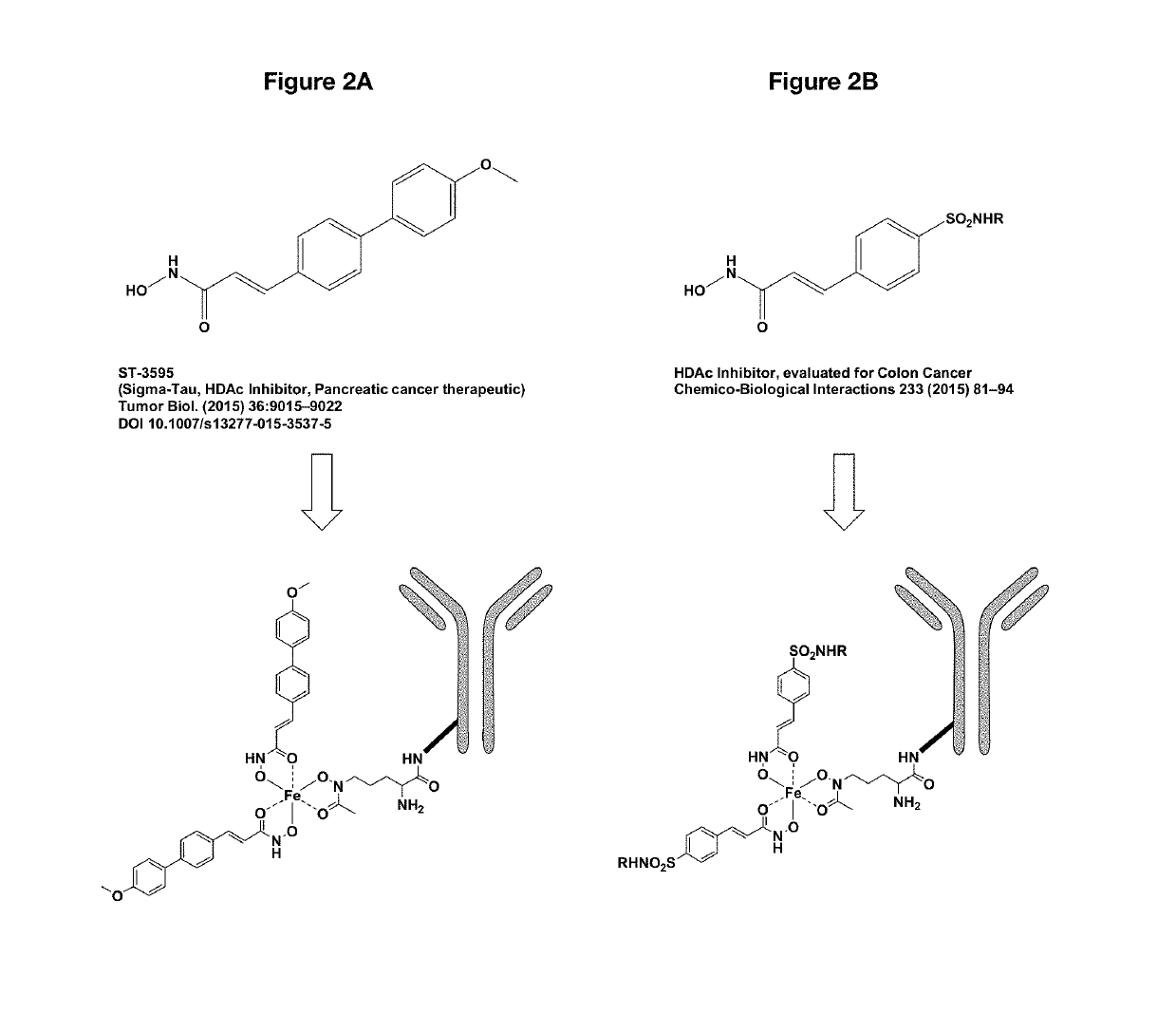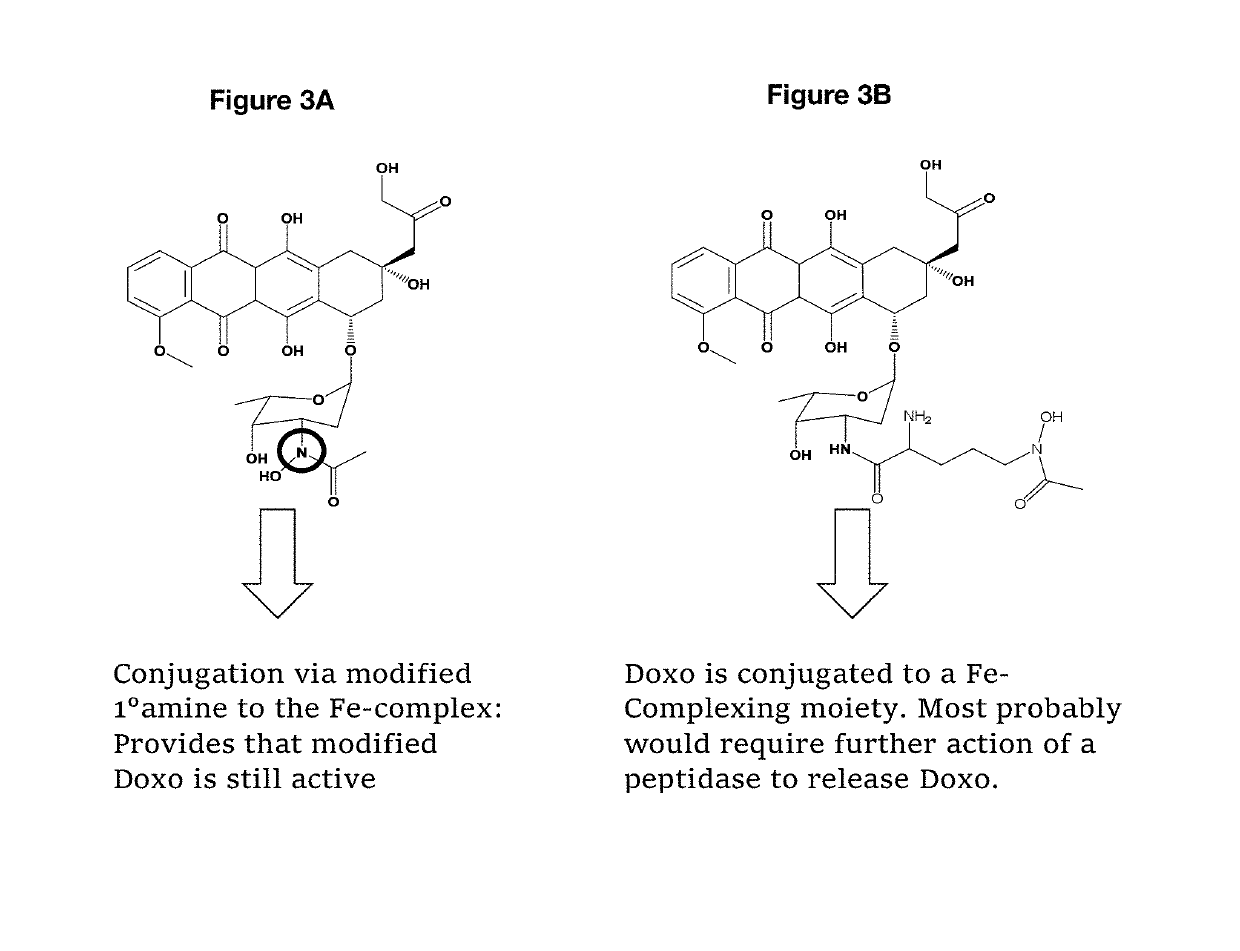Antibody drug conjugates
a technology of conjugates and antibodies, applied in the field of antibodydrug conjugates, can solve the problems of insufficient potency of monoclonal antibodies to be therapeutically active on their own, adcs, and many other problems, to achieve the effect of preventing or at least substantially reducing the release of undesired drugs in the blood stream, improving the intracellular release of active agents, and improving the effect of drug releas
- Summary
- Abstract
- Description
- Claims
- Application Information
AI Technical Summary
Benefits of technology
Problems solved by technology
Method used
Image
Examples
example 1
[0197]To assess the stability of the complexes that we intended to use for the above described linkers, a number of experiments were conducted. To this end, two model-ligands (GVFe35 and ST088) were synthesized (See Scheme 1).
[0198]Using these two ligands, the following two model complexes were prepared by addition of FeCl3 solution.
[0199]The formulae show the structures of iron complexes formed using GVFe35 (free carbonic acid, Complex A) and ST088 (sec-butylamine coupled, Complex B).
[0200]Assessing the complex stability at different pHs over time, Complex A was then incubated at pH 5.0 or pH 8.0 at 37° C. Eventual degradation of the complex was monitored by analytical HPLC at regular time-intervals and after 16 h. The HPLC-chromatograms are depicted in FIGS. 4A and 4B. It follows, that after 16 h only modest degradation could be observed in both cases, indicating that under these conditions the complexes are stable.
example 2
[0201]To examine if ligand exchange occurs (i.e. ligand dissociation and renewed complexation), an additional experiment was conducted, whereby both complexes A and B were mixed and incubated at 37° C. at pH 7.0 for 16 h. In case of dissociation and subsequent complexation one would expect intermediate complexes, whereby one or two ligands of complex B would complex iron together with one ligand stemming from complex A or vice versa.
[0202]Both complexes and the mixture were examined by analytical HPLC (See FIG. 5). Due to the more apolar sec-butyl amide function in ST088, that was used for complex B, this complex has a longer retention time than complex A. Therefore, in case of ligand exchange, peaks with intermediate retention time would start occurring between the two complex peaks. Since no intermediate peaks were observed, this suggests that no ligand exchange occurs for the examined complexes, indicating high stability.
example 3
[0203]To further corroborate this result and to examine the influence of the irons oxidation state, further experiments were conducted. Free ligand was mixed with FeCl3, giving complex A that was subsequently reduced by hydrogenation:
[0204]Ligand, complex A, and reduced material were analyzed by analytical LC (See FIG. 6). It is shown that complex A has a longer retention time than the free ligand. However, after reduction, only a peak with the same retention time as the native ligand shows. From this, it must be concluded that the reduced complex is destabilized, leading to decomplexation which in turn results in un-complexed ferrous iron and the free ligands. A complementary experiment showed respective results for the oxidation of Fe(II) in the presence of free ligand and air.
PUM
| Property | Measurement | Unit |
|---|---|---|
| pH | aaaaa | aaaaa |
| pH | aaaaa | aaaaa |
| structure | aaaaa | aaaaa |
Abstract
Description
Claims
Application Information
 Login to View More
Login to View More - R&D
- Intellectual Property
- Life Sciences
- Materials
- Tech Scout
- Unparalleled Data Quality
- Higher Quality Content
- 60% Fewer Hallucinations
Browse by: Latest US Patents, China's latest patents, Technical Efficacy Thesaurus, Application Domain, Technology Topic, Popular Technical Reports.
© 2025 PatSnap. All rights reserved.Legal|Privacy policy|Modern Slavery Act Transparency Statement|Sitemap|About US| Contact US: help@patsnap.com



